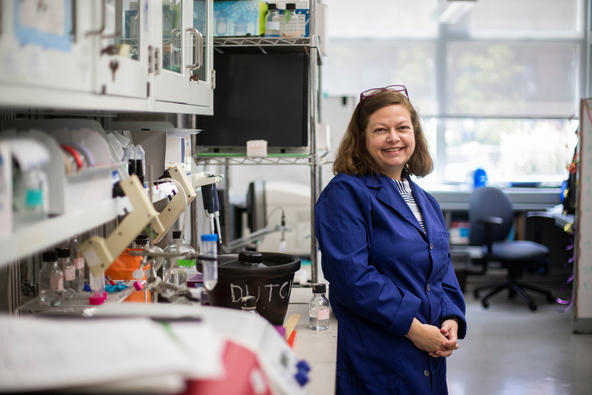UK Study Reveals Characteristics of SARS-CoV-2 Spike Protein

A new University of Kentucky College of Medicine study published in the Journal of Biological Chemistry provides foundational information about SARS-CoV-2’s spike protein.
The spike protein is found on the surface of SARS-CoV-2, the virus that causes COVID-19, and is responsible for its entry into host cells. Because of this function, it is the focus of most COVID-19 vaccines including the Pfizer/BioNTech and Moderna mRNA vaccines.
“The spike protein represents one of the most important therapeutic targets for COVID-19,” said study lead Becky Dutch, vice dean for research in the College of Medicine and chair of the Department of Molecular and Cellular Biochemistry. “This study gives scientists a more comprehensive understanding of how the protein works, which is significant to the continued development of vaccines and therapeutics.”
Dutch’s study provides insight into how stable the spike protein is, how it promotes cell-to-cell fusion and how it is modified. Her team examined the effect of mutations in clinical isolates of the virus on protein stability and function. They also observed spike protein synthesis and processing in bat cells to understand if any differences were observed.
The study found that the majority of the spike protein degrades within 24 hours, which provides more understanding about the process of infection and vaccination. Since mRNA vaccines work by giving instructions to our cells to make the spike protein, this finding gives insight into how long the newly made protein will be present.
Dutch’s team also examined the role of key host factors in cell-to-cell fusion. In addition to binding the virus to target cells, the spike protein can cause fusion between the cell it is made in and a neighboring cell, an effect seen in the lungs of COVID-19 patients.
Dutch says there has been relatively little research done on the spike protein’s cell-to-cell fusion or stability, so the study will contribute to giving researchers a full picture of how the proteins are made and how they function.
Research reported in this publication was supported by the National Institute of Allergy and Infectious Diseases of the National Institutes of Health under Award Number R01AI051517 and the National Center for Research Resources of the National Institutes of Health under Award Number P20RR02017. The content is solely the responsibility of the authors and does not necessarily represent the official views of the National Institutes of Health.
This research was also supported by a CCTS CURE Alliance pilot award. The COVID-19 Unified Research Experts (CURE) Alliance is funded by the Office of the Vice President for Research and the College of Medicine.
Credits
Elizabeth Chapin (Research Communication)
